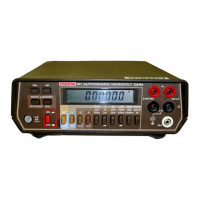
Do you have a question about the Keithley 197 and is the answer not in the manual?
| Brand | Keithley |
|---|---|
| Model | 197 |
| Category | Multimeter |
| Language | English |
Overview of the Model 197's capabilities and manual structure.
Highlights key functionalities and features of the Model 197 multimeter.
Details regarding the product warranty and service contact information.
Information on updates or changes to the manual post-publication.
Explanation of safety icons and technical terms used in the manual.
Technical performance parameters and limits of the Model 197.
Procedures for checking the instrument upon receipt for damage.
Step-by-step guide for setting up and performing the first operation.
List and description of optional accessories available for the Model 197.
Overview of bench operation procedures and capabilities.
Crucial safety guidelines for working with high-energy circuits.
Essential steps to prepare the instrument before operation.
Instructions for connecting and using AC line power.
Information on operating the Model 197 using the optional battery pack.
Procedures for charging the Model 197's battery pack.
Detailed description of the instrument's front panel controls and display.
Explanation of the LCD display and its annunciators.
Detailed explanation of each button and its function on the front panel.
Description of the input terminals and their usage.
Procedure for replacing the internal current fuse.
Identifies common error messages and their meanings.
Specifies environmental factors and input limits for operation.
Procedures for performing common measurements like voltage, resistance, and current.
Step-by-step guide for measuring DC voltages.
Procedures for measuring True RMS AC voltages accurately.
Factors affecting accuracy when measuring microvolt signals.
Procedures for measuring resistance using 2- or 4-terminal methods.
Step-by-step guide for measuring DC and TRMS AC currents.
Method for measuring signals with both AC and DC components.
Procedures for measuring signals in decibels (dB).
Explains the importance and functionality of TRMS measurements.
Purpose of performance verification procedures.
Recommended ambient conditions for accurate performance testing.
Lists the necessary equipment for verifying instrument performance.
Prerequisites for performing verification procedures correctly.
Step-by-step procedures for checking the instrument's accuracy.
Procedure to verify the accuracy of DC voltage measurements.
Procedure to verify the accuracy of AC voltage measurements.
Procedure to verify the accuracy of resistance measurements.
Procedure to verify the accuracy of DC current measurements.
Procedure to verify the accuracy of AC current measurements.
Overview of the theory of operation section and its content.
High-level overview of the Model 197's functional architecture.
Explanation of the analog components and their functions within the instrument.
Explanation of the digital components and their roles in instrument operation.
Process for performing digital calibration on the instrument.
Details on the internal power supply components and operation.
Theory of operation for the Model 1978 rechargeable battery pack.
Overview of the maintenance, service, and calibration procedures.
Steps required to safely open and reassemble the instrument for servicing.
Procedure for installing the Model 1978 rechargeable battery pack.
Instructions for changing the instrument's line voltage setting.
Procedures for replacing internal line and current fuses.
Detailed procedure for calibrating the instrument's front panel settings.
Lists the necessary equipment for performing calibration.
Information about the calibration switch and its function.
Step-by-step calibration procedure for DC voltage functions.
Step-by-step calibration procedure for AC voltage functions.
Procedure for performing frequency compensation if necessary.
Guidance on diagnosing and resolving common instrument problems.
Description of the instrument's power-up sequence and self-checks.
How to use the built-in diagnostic program for troubleshooting.
Procedures for checking the instrument's power supply and battery pack.
Guidance on checking signal conditioning circuits using diagnostic modes.
Precautions for handling components sensitive to electrostatic discharge.
Purpose of the replaceable parts section.
Lists of parts available for replacement and their schematic designations.
How to obtain replacement parts, including required information.
Procedure for returning the instrument for factory service.
References to technical drawings for component identification and circuit layout.
